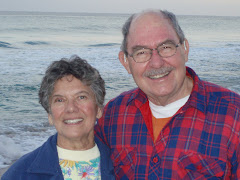We walked on down to the shore of the Bay of Fundy in front of Roosevelt’s cottage. We could see off shore a number, perhaps twenty, large salmon cages grouped together about a quarter of a mile off-shore. (See picture.) There were two groups of cages, about a couple of miles separating the two groups. There is some controversy on whether farming salmon is environmentally friendly. Some say it preserves the fishery, others say, since salmon feed is composed predominantly of fish meal, farming salmon is actually destroying a fishery. Others say that intense farming of salmon in the sea is polluting the ocean, while others say that places such as the Bay of Fundy with extreme tidal flows, are an ideal place for farming, since the waste (salmon feces) are washed out to the ocean, where it is diluted to such a degree that contamination is insignificant. Who know how this argument will play out. As in most such arguments, I suspect the truth is in between the two points of view.

On Saturday we left the most easterly point of Maine (and the United States) and started on our journey to the Gaspe Peninsular, planning to take the trip in easy steps. We drove up Route 1 to Houlton, Maine. Northern Maine is sparsely populated, so the area seems quite wild. I found it reminiscent of Alaska and the Yukon Territory in Canada – lots of trees, few houses, and fairly long distances between towns. The roads seem to alternate between stretches of new pavement and stretches of bumpy pavement in poor repair.
We fueled up in Houlton (fuel being about half the price in the US compared to Canada), and crossed the border into New Brunswick. We continued north on a wonderful four-lane Canadian highway, and spent the evening in New Brunswick. The next day we arrived in the province of Quebec.
We have decided to go around the Gaspe peninsular in a counterclockwise direction, so that we will be on driving on the side of the highway towards the sea. On our first day we stayed at a small village, Nouvelle. The south side of the Gaspe Peninsular is quite flat, and I have read it is warmer than the rest of the Gaspe area. The land here is relatively flat, and the sea quite shallow. Here in Nouvelle there are rather large tidal flats. To the north, towards our backs, when facing the sea, are heavily forested mountains.
Yesterday we visited Parc de Miguash, a museum, which is also a national park. This park was developed about twenty five years ago to preserve and the remains of fossil fish and plants found in a cliff. This cliff holds a unique collection of the remains of fish from the Devonian period. The Devonian period was a time when the species of boney and cartilaginous fish expanded, and was the period just before fish developed into land animals. (Apologies to Creationist, but I just don’t see how you can put the existence of these fossils into the Creationist view of life.) There are many species of fossil fish that were deposited during the Devonian period. Apparently conditions were just right so the fish sank in the mud, which eventually turned into shale. Many of the fossils were preserved intact, to such a degree that fossilized nerves and blood vessels can be seen. I was surprised to learn that the current view is that fish probably developed lungs to breathe air and limbs, long before they emerged on land. The limbs that were developed were used for swimming, initially, not walking or crawling.
We fueled up in Houlton (fuel being about half the price in the US compared to Canada), and crossed the border into New Brunswick. We continued north on a wonderful four-lane Canadian highway, and spent the evening in New Brunswick. The next day we arrived in the province of Quebec.
We have decided to go around the Gaspe peninsular in a counterclockwise direction, so that we will be on driving on the side of the highway towards the sea. On our first day we stayed at a small village, Nouvelle. The south side of the Gaspe Peninsular is quite flat, and I have read it is warmer than the rest of the Gaspe area. The land here is relatively flat, and the sea quite shallow. Here in Nouvelle there are rather large tidal flats. To the north, towards our backs, when facing the sea, are heavily forested mountains.
Yesterday we visited Parc de Miguash, a museum, which is also a national park. This park was developed about twenty five years ago to preserve and the remains of fossil fish and plants found in a cliff. This cliff holds a unique collection of the remains of fish from the Devonian period. The Devonian period was a time when the species of boney and cartilaginous fish expanded, and was the period just before fish developed into land animals. (Apologies to Creationist, but I just don’t see how you can put the existence of these fossils into the Creationist view of life.) There are many species of fossil fish that were deposited during the Devonian period. Apparently conditions were just right so the fish sank in the mud, which eventually turned into shale. Many of the fossils were preserved intact, to such a degree that fossilized nerves and blood vessels can be seen. I was surprised to learn that the current view is that fish probably developed lungs to breathe air and limbs, long before they emerged on land. The limbs that were developed were used for swimming, initially, not walking or crawling.

No comments:
Post a Comment